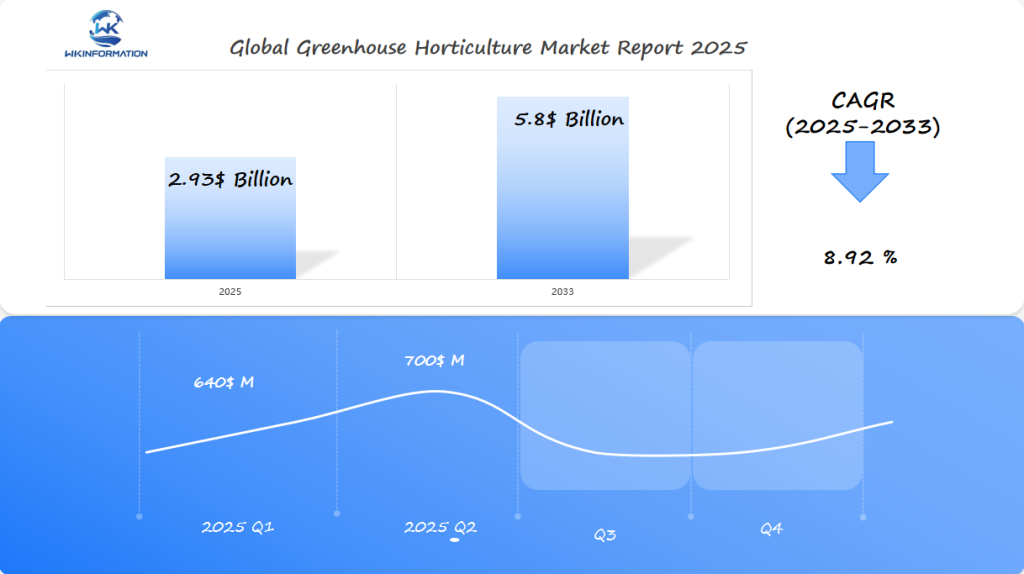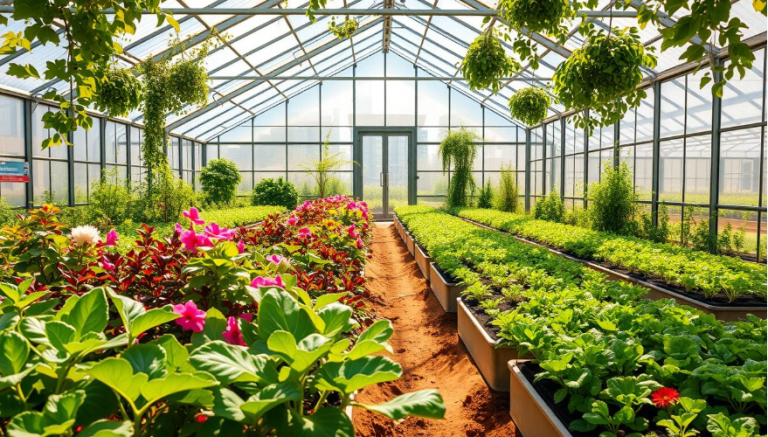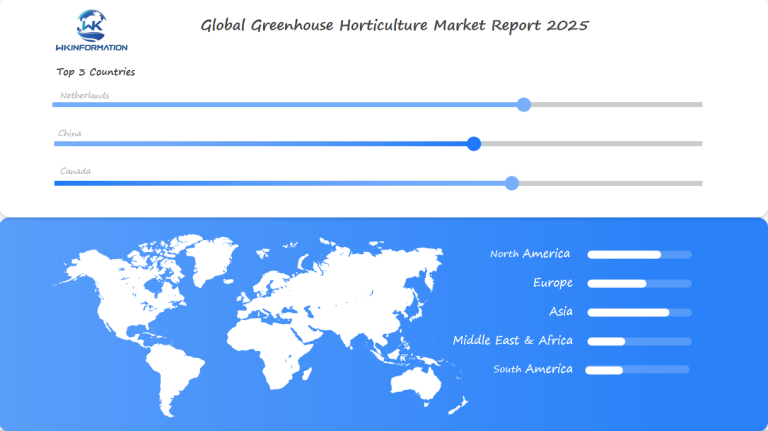Greenhouse Horticulture Market Projected to Reach $2.93 Billion Globally by 2025: Controlled Environment Agriculture in the Netherlands, China, and Canada
Explore the expanding Greenhouse Horticulture Market as it evolves with advanced technologies, sustainable practices, and rising demand for controlled environment agriculture solutions worldwide.
- Last Updated:
Greenhouse Horticulture Market Forecast for Q1 and Q2 2025
The Greenhouse Horticulture market is forecasted to reach $2.93 billion in 2025, supported by a CAGR of 8.92% through 2033, fueled by the global demand for sustainable food production and year-round crop cultivation. Market size for Q1 2025 is estimated at $640 million, as growers ramp up operations to meet seasonal demands and new technology adoption. Growth is anticipated to accelerate in Q2, reaching approximately $700 million, aided by advances in climate control systems and automation.

Key Takeaways
- The global greenhouse horticulture market is expected to reach $2.93 billion by 2025.
- Controlled environment agriculture offers sustainable food production solutions.
- Advanced greenhouse technologies enable precise crop management.
- Innovative techniques overcome traditional agricultural limitations.
- There is significant investment potential in the greenhouse horticulture sector.
Upstream and downstream supply chain considerations in greenhouse horticulture
The greenhouse horticulture industry has a complex supply chain. It connects key parts from the start to the end. Knowing these details is key for success and staying financially stable.
Upstream: Getting the Right Inputs
Upstream, the focus is on getting the right greenhouse inputs. Growers pick top-quality stuff that affects how well crops grow:
- Premium seed varieties
- Advanced growing media
- Specialized nutrient solutions
- Climate control equipment
Downstream: Getting Produce to Market
Getting produce to market is crucial. Good logistics mean faster, better, and cheaper food for everyone.
Greenhouse operations use smart strategies to improve their supply chain:
- Using tech for tracking
- Building strong ties with suppliers
- Creating flexible delivery systems
- Investing in keeping food cold
Greenhouse horticulture thrives when inputs and markets work together smoothly. By working on the supply chain, growers can do better, waste less, and make more money.
Current market trends advancing controlled environment agriculture
The way we grow food is changing fast, thanks to new tech in controlled environment agriculture. Vertical farming is leading this change. It lets farmers grow crops in layers indoors.
New tech is changing how we grow crops:
- Hydroponics systems grow plants without soil, using water full of nutrients
- Aeroponics boosts crop yields by keeping roots in mist
- Smart greenhouses use advanced tools to control the climate
Vertical farming is great for cities. It grows more food than old ways, using less land and water.
| Technology | Water Usage | Space Efficiency | Crop Yield Potential |
| Traditional Farming | High | Low | Standard |
| Hydroponics | 90% Less | High | 2-3x Higher |
| Vertical Farming | 95% Less | Very High | 4-6x Higher |
Studies show these new methods can help solve world hunger. They make it possible to grow food all year, in perfect conditions.
Constraints related to climate, energy, and regulation
The greenhouse horticulture industry faces big challenges from climate change, energy use, and complex rules. Growers must deal with tough environmental conditions while keeping productivity and sustainability high.
Climate Change Challenges
Climate change is a big problem for controlled environment agriculture. Extreme weather disrupts traditional growing cycles and makes it hard to predict crops. Greenhouse operators need to find ways to adapt and reduce these risks.
- Rising temperatures impact crop yields
- Unpredictable precipitation patterns create cultivation challenges
- Increased potential for pest and disease transmission
Energy Efficiency Concerns
Energy efficiency is a big concern for greenhouses. Modern greenhouses need advanced climate control systems that use a lot of electricity. New technologies are being developed to cut down energy use and lessen environmental harm.
| Energy Challenge | Mitigation Strategy |
| High electricity consumption | Solar panel integration |
| Heating and cooling costs | Advanced insulation techniques |
| Carbon footprint | Renewable energy sources |
Regulatory Compliance Issues
Following rules is another challenge for greenhouse horticulture. Different places have different environmental standards. Greenhouse operators need to be flexible and adapt to these rules. They must also keep up with changing regulations.

Geopolitical factors influencing greenhouse horticulture trade and technology
The global greenhouse horticulture industry faces many challenges and opportunities. Geopolitical factors greatly affect how technology is shared and markets are accessed for new farming methods.
Important geopolitical factors in the greenhouse horticulture sector include:
- Trade policy talks between big agricultural producers
- Agreements on sharing technology
- Regional economic cooperation efforts
- Rules on using and protecting new farming technologies
Trade barriers can greatly affect greenhouse horticulture growth. Countries with good technology sharing partnerships have an edge in developing new farming ways. Emerging markets are looking for partnerships to speed up farming innovation.
Getting into new markets is key for growing greenhouse technology. Countries with open investment policies and good rules attract more tech investments in farming.
- The United States is a leader in advanced greenhouse technology
- The European Union supports sharing agricultural innovations across borders
- Asian markets quickly adopt new technologies
Geopolitical tensions can mess up greenhouse horticulture supply chains. This makes it hard to share technology and enter new markets. To succeed, companies need to plan carefully and be flexible in these complex global situations.
Market Segmentation by Greenhouse Types and Technologies
The greenhouse horticulture market is full of different designs and tech. Glass and plastic greenhouses are key players in boosting farm productivity and managing crops.
Each greenhouse type has its own benefits for growing crops:
- Glass greenhouses last long and let in lots of light
- Plastic greenhouses are cheaper and lighter
- Climate control systems help manage the environment in both
Today’s greenhouses use advanced tech for better control:
- They have automated systems to watch the environment
- They use smart irrigation and lighting
- They can be managed from afar
New greenhouse tech is changing farming, giving farmers more control over growing conditions.
Application analysis focusing on vegetable, flower, and specialty crop production
Greenhouse horticulture has changed how we grow crops. It gives us control over the growing environment. This has made growing vegetables, flowers, and herbs in greenhouses very successful.
Vegetable Production
Greenhouse vegetable production is key in controlled environment agriculture. Farmers use new technologies to improve growth. This leads to:
- Year-round crop cultivation
- Reduced water consumption
- Increased crop density
- Minimized pest interference
Flower Production
Ornamental plants do well in greenhouses. Growers control light, temperature, and humidity. This makes flowers vibrant and valuable in the market.
Herb Production
Medicinal herbs are also grown in greenhouses. This method allows for:
- Standardized active compound concentrations
- Consistent plant quality
- Reduced contamination risks
- Enhanced genetic stability
New greenhouse technologies are changing crop production. They offer sustainable solutions to global agricultural problems.
Global regional market developments in greenhouse horticulture
The world of greenhouse horticulture is changing fast. In Europe, countries like the Netherlands are leading the way. They use the latest technology and sustainable methods.
In North America, new tech and more people wanting local food are boosting the market. Vertical farming and controlled environments are key to solving farming problems.
Key developments in different regions
- European regions demonstrate highest technological sophistication
- North American markets focus on sustainable production methods
- Asian greenhouse sector shows rapid infrastructure expansion
The Asian greenhouse market is growing fast. Countries like China and Japan are building more greenhouses. They use new tech to grow more food and meet food needs.
Unique approaches of each region
Each region has its own way of doing things:
- Europe: Precision agriculture and sustainability
- North America: Technology-driven production
- Asia: Infrastructure and scalability
Different strategies are coming together. This mix is shaping the future of growing food in controlled environments worldwide.

Netherlands' innovation in greenhouse technology and exports
The Netherlands leads the world in greenhouse horticulture, making big strides in Dutch greenhouse technology. This small country has turned agricultural innovation into a top export.
Wageningen University research centers play a key role in creating new controlled environment agriculture strategies. The country’s innovation hubs have built advanced greenhouse systems. These systems boost crop production and use fewer resources.
- Developed precision climate control technologies
- Created water-efficient irrigation systems
- Pioneered sustainable crop management techniques
Dutch horticultural exports have a strong presence worldwide. The Netherlands sends greenhouse technologies and expertise to many continents. It’s seen as a top leader in agricultural technology.
The Netherlands keeps investing in research and development. This ensures it stays a global leader in greenhouse technology and agricultural innovation.
China's Expanding Greenhouse Infrastructure
China is leading the way in agricultural technology with its fast-growing greenhouse projects. The country is focusing on urban farming, changing how we grow food. Solar greenhouses are key, helping crops grow well even in tough places.
New projects in China show big steps forward in growing food indoors. The Jiashan Agriculture Center is a top example. It shows China’s skill in making farming better with technology.
Key Benefits of China’s Greenhouse Initiatives
- Sustainable greenhouse designs increase crop yields
- Urban agriculture projects reduce land use pressures
- Solar greenhouses minimize energy consumption
China is becoming a top player in farming technology with its greenhouses. Solar greenhouse tech lets crops grow all year, solving food problems and helping the planet.
China’s farming is not just old ways anymore. It uses new tech to grow food better. This helps cities grow food efficiently, solving space issues.
Canada's Growing Controlled Environment Agriculture Sector
The Canadian greenhouse industry is a global leader in controlled environment agriculture. It uses advanced technologies and new ways to grow food. This is especially important in Canada’s tough climate, where growers use special greenhouses to grow crops all year.
Canada’s controlled environment agriculture sector is strong because of:
- Advanced climate control technologies
- High-efficiency growing systems
- Strategic investment in agricultural innovation
- Robust regulatory framework for crop production
Cannabis cultivation is a big part of Canada’s greenhouse technology. The legal cannabis market has led to more investment in greenhouse technology. This has opened up new chances for growing food with precision.
| Crop Category | Annual Production Volume | Greenhouse Technology Level |
| Vegetables | 1.2 million tons | High-tech environmental control |
| Cannabis | 200,000 kg | Advanced climate management |
| Ornamental Crops | 500,000 units | Precision lighting systems |
Canada keeps investing in research and development. This keeps the greenhouse industry at the top of global agriculture. It shows great promise for growing food and specialty crops in a sustainable and tech-driven way.
Future development paths for greenhouse horticulture innovations
The future of greenhouses is changing fast with new tech. AI is making farming smarter, helping farmers watch over crops better and use resources wisely.
How IoT Solutions Are Transforming Greenhouses
New IoT solutions are making greenhouses smarter. They help farmers manage crops better. Growers can now:
- Watch over plant health in real-time
- Improve climate control
- Use less water and energy
- See problems before they start
The Importance of Sustainable Farming in Addressing Global Challenges
As the world faces more farming challenges, growing plants sustainably is key. New greenhouse tech is tackling these issues head-on.
| Technology | Impact | Potential Efficiency Gain |
| AI Crop Monitoring | Precision Agriculture | 25-40% |
| IoT Climate Control | Resource Optimization | 30-50% |
| Renewable Energy Integration | Sustainability | 35-55% |
AI, machine learning, and sensors will keep pushing greenhouses toward better, greener farming.
Competitive landscape in greenhouse horticulture technologies
Key players in the greenhouse horticulture market are focusing on technological advancements to enhance crop yields and resource efficiency. They are expanding operations in rapidly urbanizing regions such as Asia-Pacific, where the demand for sustainable and locally grown produce is increasing. Strategic collaborations with agricultural technology firms and investments in climate-controlled systems and renewable energy integration are enabling these companies to strengthen their market presence and support the transition toward resilient and eco-friendly food production systems.
Key Players:
-
Signify (Philips Lighting) (Netherlands)
-
Osram (Germany)
-
Heliospectra (Sweden)
-
Hortilux Schréder (Netherlands)
-
Certhon (Netherlands)
-
Priva (Netherlands)
-
Van der Hoeven Horticultural Projects (Netherlands)
-
Dalsem (Netherlands)
-
Hoogendoorn Growth Management (Netherlands)
-
Koppert Biological Systems (Netherlands)
Overall
| Report Metric | Details |
|---|---|
| Report Name | Global Greenhouse Horticulture Market Report |
| Base Year | 2024 |
| Segment by Type |
· Glass Greenhouses · Plastic Greenhouses |
|
Segment by Application |
· Vegetable · Flower · Specialty Crop Production |
| Geographies Covered |
· North America (United States, Canada) · Europe (Germany, France, UK, Italy, Russia) · Asia-Pacific (China, Japan, South Korea, Taiwan) · Southeast Asia (India) · Latin America (Mexico, Brazil) |
| Forecast units | USD million in value |
| Report coverage | Revenue and volume forecast, company share, competitive landscape, growth factors and trends |
Global Greenhouse Horticulture Market Report (Can Read by Free sample) – Table of Contents
Chapter 1: Greenhouse Horticulture Market Analysis Overview
- Competitive Forces Analysis (Porter’s Five Forces)
- Strategic Growth Assessment (Ansoff Matrix)
- Industry Value Chain Insights
- Regional Trends and Key Market Drivers
- Greenhouse Horticulture Market Segmentation Overview
Chapter 2: Competitive Landscape
- Global Greenhouse Horticulture Players and Regional Insights
- Key Players and Market Share Analysis
- Sales Trends of Leading Companies
- Year-on-Year Performance Insights
- Competitive Strategies and Market Positioning
- Key Differentiators and Strategic Moves
Chapter 3: Greenhouse Horticulture Market Segmentation Analysis
- Key Data and Visual Insights
- Trends, Growth Rates, and Drivers
- Segment Dynamics and Insights
- Detailed Market Analysis by Segment
Chapter 4: Regional Market Performance
- Consumer Trends by Region
- Historical Data and Growth Forecasts
- Regional Growth Factors
- Economic, Demographic, and Technological Impacts
- Challenges and Opportunities in Key Regions
- Regional Trends and Market Shifts
- Key Cities and High-Demand Areas
Chapter 5: Greenhouse Horticulture Emerging and Untapped Markets
- Growth Potential in Secondary Regions
- Trends, Challenges, and Opportunities
Chapter 6: Product and Application Segmentation
- Product Types and Innovation Trends
- Application-Based Market Insights
Chapter 7: Greenhouse Horticulture Consumer Insights
- Demographics and Buying Behaviors
- TargetAudience Profiles
Chapter 8: Key Findings and Recommendations
- Summary of Greenhouse Horticulture Market Insights
- Actionable Recommendations for Stakeholders

Access the study in MULTIPLEFORMATS
Didn’t find what you’re looking for?
TALK TO OUR ANALYST TEAM
Need something within your budget?
NO WORRIES! WE GOT YOU COVERED!
Call us on: +1-866-739-3133
Email: infor@wkinformation.com
What is the projected market value for greenhouse horticulture by 2025?
The greenhouse horticulture market is expected to hit $2.93 billion by 2025. This growth is fueled by new tech in controlled environments and innovative growing methods.
What are the key technologies transforming greenhouse horticulture?
New tech like vertical farming, hydroponics, aeroponics, and smart greenhouses are changing the game. They boost crop yield, quality, and use resources better.
How is climate change impacting greenhouse operations?
Climate change is a big challenge for greenhouses. They need better climate control, energy-saving tech, and crops that can handle tough weather.
Which countries are leading in greenhouse horticulture innovation?
The Netherlands, China, and Canada are leading the way in greenhouse horticulture innovation. They’re known for their advanced technology, significant investments, and creative growing methods.
What types of crops are typically grown in greenhouses?
Greenhouses grow many crops, like veggies, flowers, herbs, and even cannabis. Each crop needs its own special conditions and tech.
What new technologies are shaping the future of greenhouse horticulture?
New technologies such as artificial intelligence (AI), the Internet of Things (IoT), and advanced climate control systems are transforming greenhouses. These innovations also prioritize efficient water and energy usage.
How do supply chain dynamics affect greenhouse horticulture?
A good supply chain is key. It means getting the right seeds and fertilizers, managing distribution, and reaching markets to stay profitable.
What are the main challenges in greenhouse horticulture?
The main challenges in greenhouse horticulture are:
- Keeping energy costs down
- Dealing with climate change
- Following complex rules and regulations
- Overcoming technological limitations
- Staying competitive in the market
How are international trade policies impacting greenhouse horticulture?
Trade policies, technology sharing rules, and global events like pandemics affect greenhouses. They impact market trends and how competitive they can be.
What role does sustainability play in modern greenhouse horticulture?
Sustainability is key now. The focus is on using renewable energy, saving water, and adopting circular economy practices. They aim to grow in an eco-friendly way.

